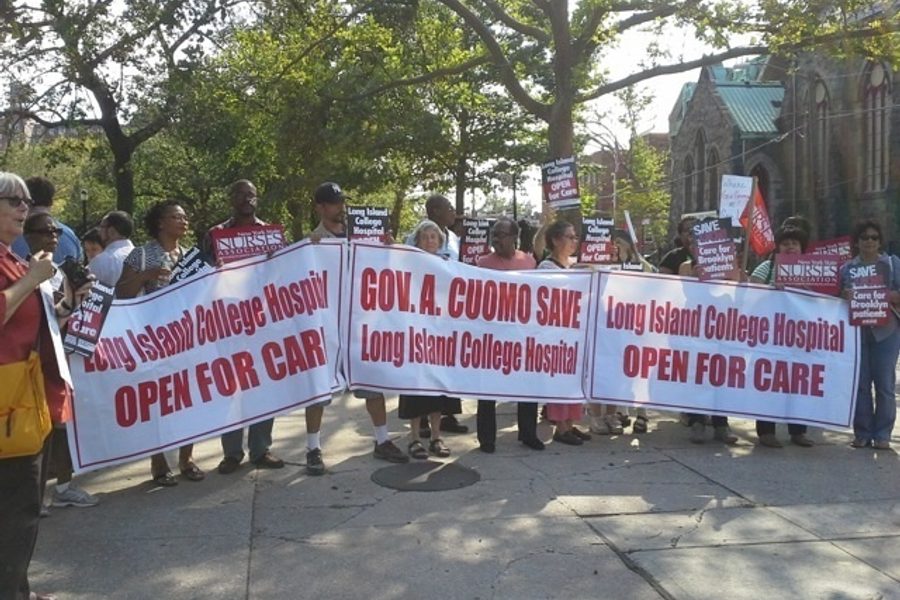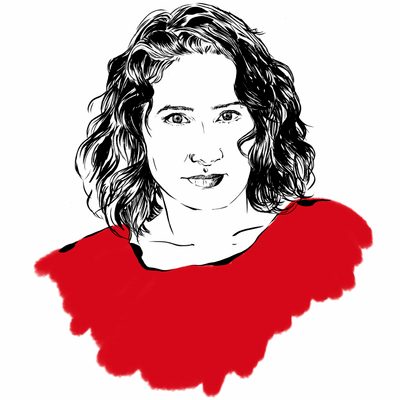
The emergency room at Methodist Hospital in Park Slope, Brooklyn was crowded when we got there at 5:30 PM on Tuesday evening. We were the third-place team in a race to different Brooklyn hospitals staged by the New York State Nurses Association to dramatize the need to save two facilities in danger of closing. When we arrived, Methodist Hospital nurses were too busy to talk to our group about the ER’s patient load, but the man at the desk said they’d been busier since Long Island College Hospital (LICH) started diverting ambulances at the end of June.
LICH, which serves serve Red Hook, Brooklyn Heights, Cobble Hill and Downtown Brooklyn, has been on the verge of closing for months, while NYSNA, 1199 SEIU, LICH doctors and community members fight to keep it open.
Currently, the only thing keeping SUNY Downstate Medical Center from shutting the hospital completely is a temporary restraining order acquired by Public Advocate (and mayoral candidate) Bill deBlasio—a TRO obtained by NYSNA, 1199, and LICH physicians still exists, but hearings on whether SUNY is in contempt of court have been stayed after an appeal.
At 5pm, de Blasio had waved the green flag to start off the “Race for Care” in Red Hook’s Coffey Park, noting to the assembled crowd that the Brooklyn neighborhood is underserved medically and had been devastated by Superstorm Sandy. He’d brought maps with him demonstrating the distances to local hospitals with and without LICH. For Red Hook’s residents, many of whom are public housing residents living on low incomes, the nearest emergency room would be miles away.
As the race began, three teams set off in cars; one for LICH, one for Brooklyn Hospital in Fort Greene, and one for Methodist. An additional team headed to Methodist via public transportation — a torturous journey from Red Hook. (For reference, it took me nearly an hour to reach Coffey Park via public transit from my Crown Heights apartment.) I tagged along in the Methodist car with Gabe Kristal of NYSNA and Margaret Weber, an audiologist who once worked at LICH and whose family has relied heavily on the hospital over her 30 years in Brooklyn Heights. Her son was born at the hospital; her husband was treated there after a stroke and continues to volunteer at the hospital.
“I remember looking out the window and thinking it was really nice,” she said of her time at the hospital. “Now I realize that’s part of the downfall.”
Care, not condos
“Care, not condos” has been a rallying cry of the movement to save LICH, which sits on land valued at some $500 million in a rapidly gentrifying area. The nurses, who have been fielding calls asking them to come work elsewhere, demonstrate by sticking with the fight that patient care, not just self-interest, is central to their battle.
As I wrote in Jacobin magazine recently, unions of workers whose job is caring for others — including K-12 teachers and child care workers — have scored victories by making that care visible and central in their struggles. The Chicago Teachers Union famously made their connections to the community and their concern for their students paramount in their strike, and has continued to do so as they fight alongside parents against Rahm Emanuel’s proposed school closures.
Similarly, NYC nurses have foregrounded the needs of patients in their battle to keep open both LICH and Interfaith hospital in Bedford Stuyvesant, which is also facing closure.
In particular, the “race for care” was designed to make the case that keeping LICH open is in the interests of underserved patients. The nurses stressed their connection to the community and created solidarity with the people, making the push to close the hospital look even more like the financial calculation the nurses say that it is. Researchers such as Paula England, Nancy Folbre and Carrie Leana have found that care workers will often prioritize their patients to their own detriment, foregoing demands like higher wages or shorter hours, but managers, who rarely come into contact with care recipients, will prioritize cost-cutting.
The Race for Care was a way to dramatize the struggle of the community to access hospital care. As the participants raced across Brooklyn (obeying all traffic laws, of course), passengers live-tweeted their journeys. Red lights, traffic jams and leisurely pedestrians pushing baby carriages slowed down the racers, who noted repeatedly the urgency of getting to a hospital when a life might be at stake.
“If your kid trips in Coffey Park [or] if someone goes into cardiac arrest right here, minutes count,” City Councilmember Brad Lander said at the park before the teams set off. And on the way to Methodist, Weber — whose husband was a stroke patient — noted that after a stroke, time lost is brain lost.
The LICH team made it to the (empty) emergency room in 19 minutes in heavy traffic, although a couple of supporters critical of the route jumped in their own car and made it in 14 minutes. It took about 19 minutes to get to Methodist Hospital, but circling Park Slope in search of parking and the ER entrance ate up more minutes — LICH, Kristal said, has great parking – and the Brooklyn Hospital team squeaked past for second place. It took them 24 minutes, and they found a busy ER with 25 patients awaiting care. As for the Methodist team, when we finally got to the emergency room after 29 minutes, we found patients on stretchers in the hallway and a busy waiting room.
The emergency rooms at Methodist and Brooklyn Hospitals will be even more jammed if LICH closes entirely — it is still open to walk-in patients — and Interfaith shuts down as well. Last week, the New York Times looked at the impact on psychiatric care if those hospitals close; they note that two years ago, a group appointed by New York Gov. Andrew Cuomo found that “Brooklyn would suffer a series of free-falling hospital bankruptcies and closings unless health care in the borough was restructured.”
Help wanted
Cuomo, who could intervene to reject a closure plan for the hospital, has been the primary target of the protests. So far, the nurses and community members have been disappointed in his response — or lack thereof, as he’s steadfastly stayed out of the fight. New signs reading, “Where’s Governor Cuomo?” dot neighborhood business windows.
Meanwhile, on the Public Advocate’s website, de Blasio unveiled a plan to fix hospital care in the borough last week. It calls for a Brooklyn Health Authority appointed by the mayor and governor to coordinate health spending and drive down costs, for the prevention of future closures without replacements, and for a fund that would construct new hospitals and clinics based on community need.
Without such a plan, if hospitals in high-need areas of Brooklyn shut down, the borough could face crisis. And this exposes a larger issue with healthcare access in the United States. While much of the news media is focused on the rocky implementation of so-called “Obamacare,” getting people insured is only part of the problem. The other part is ensuring that there are enough facilities to meet everyone’s need for high-quality care. The problems of running healthcare via “free markets” are made clear by the fact that two independent hospitals in one borough of one city can close at the same time — simply because it’s costly to operate a healthcare facility in a borough where, as the Times noted, one in five of its 2.5 million residents live below the poverty line.
At the rally in Coffey Park, Susan Raboy, a neighborhood resident who’s begun a network of LICH patients fighting to save the hospital, spoke of her most recent experience at the hospital. This week, after a rally, she checked herself into the ER with excruciating pain in her foot (which turned out to be a bone spur). She joked about the looks the security guards — black-suited and uniformed private guards hired in recent weeks as the protests have ramped up — gave her when she walked into the hospital carrying her protest sign, but became serious when it came to the care she received, both then and during an earlier stint in the hospital.
“They saved me, so until my last breath I’m going to save them,” she says.
Sarah Jaffe is a writer and reporter living in New Orleans and on the road. She is the author of Work Won’t Love You Back: How Devotion To Our Jobs Keeps Us Exploited, Exhausted, and Alone; Necessary Trouble: Americans in Revolt, and her latest book is From the Ashes: Grief and Revolution in a World on Fire, all from Bold Type Books. Her journalism covers the politics of power, from the workplace to the streets, and her writing has been published in The Nation, The Washington Post, The Guardian, The New Republic, the New York Review of Books, and many other outlets. She is a columnist at The Progressive and In These Times. She also co-hosts the Belabored podcast, with Michelle Chen, covering today’s labor movement, and Heart Reacts, with Craig Gent, an advice podcast for the collapse of late capitalism. Sarah has been a waitress, a bicycle mechanic, and a social media consultant, cleaned up trash and scooped ice cream and explained Soviet communism to middle schoolers. Journalism pays better than some of these. You can follow her on Twitter @sarahljaffe.







